
Oncidium, abbreviated as Onc. in the horticultural trade, is a genus that, as of December 2023, contains about 340 species of orchids from the subtribe Oncidiinae of the orchid family Orchidaceae. It is distributed across tropical and subtropical America from Mexico, Central America and the West Indies to northern Argentina, with one species (O. ensatum) extending into Florida. Common names for plants in this genus include dancing-lady orchid and golden shower orchid.

Ostrya is a genus of eight to 10 small deciduous trees belonging to the birch family Betulaceae. Common names include hop-hornbeam and hophornbeam. It may also be called ironwood, a name shared with a number of other plants.

Peristeria is a genus of plants of the family Orchidaceae commonly called dove orchid or Holy Ghost orchid. In line with the common name, the genus' name is from the Greek word peristerion meaning "from dove". According to the Royal Horticultural Society, Per is the official orchid abbreviation for this genus. In nature, it is found across much of South America as well as in Panama, Costa Rica and Trinidad.
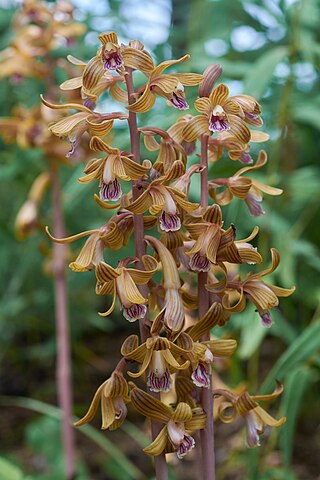
Hexalectris is a genus of the family Orchidaceae, comprising 10 known species of fully myco-heterotrophic orchids. These species are found in North America, with the center of diversity in northern Mexico. None of the species are particularly common. Hexalectris spicata has a wide distribution and is likely the most abundant member of the genus, but is nevertheless infrequent throughout its range. Other species are rare, and some, such as H. colemanii, are threatened or endangered. All species that have been studied form associations with ectomycorrhizal fungi that are likely linked to surrounding trees. Many Hexalectris species are found in association with oak trees (Quercus), which are ectomycorrhizal.

Drakaea is a genus of 10 species in the plant family Orchidaceae commonly known as hammer orchids. All ten species only occur in the south-west of Western Australia. Hammer orchids are characterised by an insectoid labellum that is attached to a narrow, hinged stem, which holds it aloft. The stem can only hinge backwards, where the broadly winged column carries the pollen and stigma. Each species of hammer orchid is pollinated by a specific species of thynnid wasp. Thynnid wasps are unusual in that the female is flightless and mating occurs when the male carries a female away to a source of food. The labellum of the orchid resembles a female thynnid wasp in shape, colour and scent. Insect pollination involving sexual attraction is common in orchids but the interaction between the male thynnid wasp and the hammer orchid is unique in that it involves the insect trying to fly away with a part of the flower.

Spermacoce or false buttonweed is a genus of flowering plants in the family Rubiaceae. It comprises about 275 species found throughout the tropics and subtropics. Its highest diversity is found in the Americas, followed by Africa, Australia and Asia.
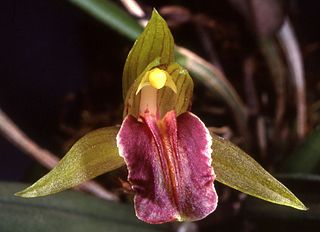
Domingoa is a genus of orchids, consisting of four currently recognised species at home in Mexico, Central America, Cuba, Hispaniola and Mona of the Greater Antilles. The genus was established in 1913 by Rudolf Schlechter. Its name refers to Santo Domingo, an older name for Hispaniola. The genus name is abbreviated Dga. in cultivation.
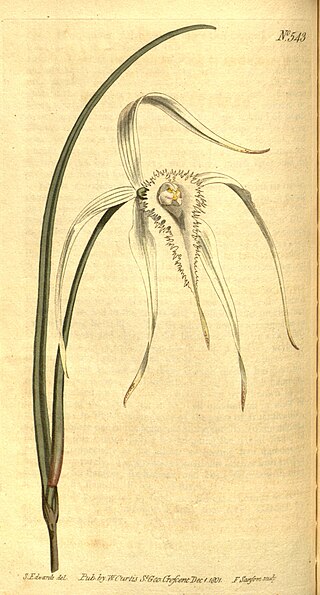
Brassavola cucullata, common name daddy long-legs orchid, is a species of orchid native to Mexico, Belize, Central America, the West Indies and northern South America.
Bulbophyllum abbreviatum is a species of orchid in the genus Bulbophyllum discovered in Madagascar and originally described by German botanist Rudolf Schlechter, from material collected by French botanist H. Perrier de la Bâthie in February 1912, which is now kept in the Muséum National d'Histoire Naturelle in Paris.
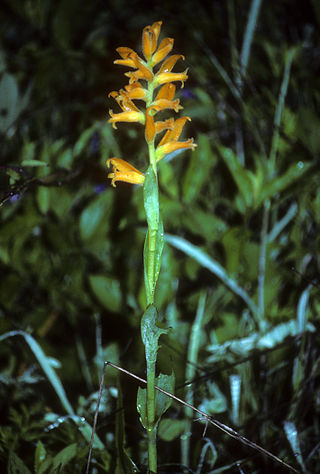
Dichromanthus is a genus of flowering plants from the orchid family, Orchidaceae. As currently delimited, it is monophyletic and includes four species:
- Dichromanthus aurantiacus(Lex.) Salazar & Soto Arenas - much of Mexico, south to Honduras
- Dichromanthus cinnabarinus(Lex.) Garay - from Texas to Guatemala
- Dichromanthus michuacanus(Lex.) Salazar & Soto Arenas - from Texas and Arizona south to Honduras
- Dichromanthus yucundaaSalazar & García-Mend. - Oaxaca
Helleriella is a genus of flowering plants from the orchid family, Orchidaceae. It contains two known species, native to Mexico and Central America.

Ionopsis is a genus of flowering plants from the orchid family, Orchidaceae. It contains 6 currently accepted species, native to Latin America, the West Indies, and Florida.
- Ionopsis burchelliiRchb.f. - Brazil
- Ionopsis minutiflora(Dodson & N.H.Williams) Pupulin - Ecuador
- Ionopsis papillosaPupulin - Ecuador
- Ionopsis satyrioides(Sw.) Rchb.f. in W.G.Walpers - widespread across southern Mexico, Central America, the West Indies, and South America
- Ionopsis utricularioides(Sw.) Lindl. - widespread across southern Mexico, Central America, the West Indies, South America, and Florida
- Ionopsis zebrinaKraenzl. - Colombia
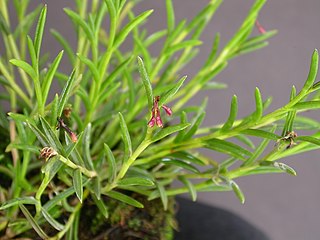
Jacquiniella is a genus of flowering plants from the orchid family, Orchidaceae. It is native to Mexico, Central America, the West Indies, and South America.

Sarcanthopsis, commonly known as goliath orchids, is a genus of six species of flowering plants from the orchid family, Orchidaceae. Plants in this genus are large epiphytes or lithophytes with long, thick, leathery stems, large, crowded leathery leaves and many yellowish flowers on a branched flowering stem. Orchids in this genus occur in New Guinea and islands of the south-west Pacific.

Schiedeella is a genus of flowering plants from the orchid family, Orchidaceae. It is native to the Western Hemisphere: Mexico, the West Indies and Central America, with one species (S. arizonica) in the southwestern United States.
Svenkoeltzia is a genus of flowering plants from the orchid family, Orchidaceae. It contains three known species, all endemic to Mexico.
- Svenkoeltzia congestiflora(L.O.Williams) Burns-Bal. - Oaxaca
- Svenkoeltzia luzmarianaR.González - Jalisco
- Svenkoeltzia patriciaeR.González - Jalisco
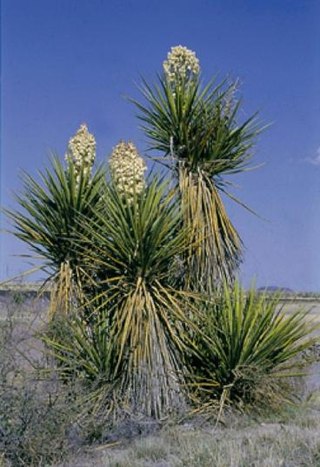
Yucca faxoniana is a bladed evergreen shrub of the genus Yucca. It is known by the common names Faxon yucca,Spanish dagger, and giant dagger.

Poliomintha is a genus of flowering plants in the mint family, Lamiaceae. It is native to the southwestern United States, Haiti, and northern Mexico.

Nolina erumpens, the foothill beargrass, mesa sacahuista, or sand beargrass, is a member of the subfamily Nolinaceae of family Asparagaceae, native to New Mexico, Texas and adjacent regions of north Mexico.
Hexalectris grandiflora, the largeflower crested coralroot or giant coral-root, is a species of orchid native to Mexico from Chihuahua south to Oaxaca, as well as to western and north-central Texas. It is a myco-heterotrophic species, lacking chlorophyll and subsisting entirely on nutrients obtained by fungi in the soil.














